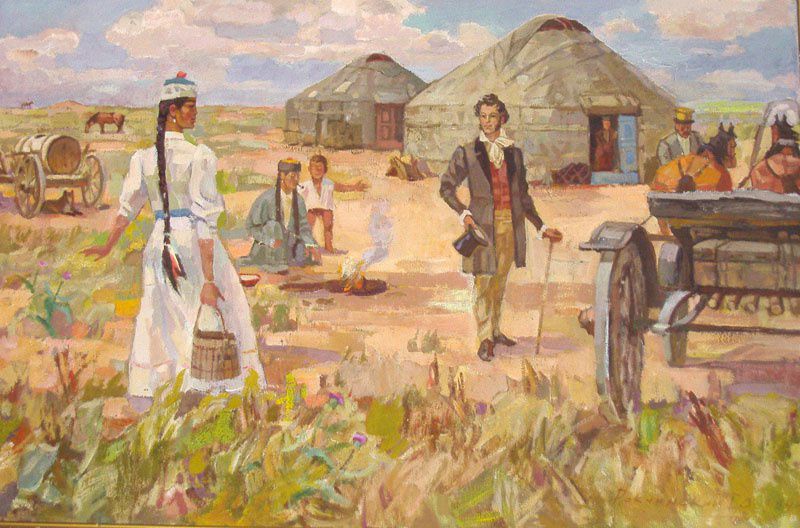The most sensational find that turned our classical idea about the history of chess was made by Yury Buryakov, a professor at the National University of Uzbekistan named after M. Ulugbek. It happened not far from Samarkand when excavating the ruins of the ancient part of the city – Afrasiab in 1990. He found a truly unique set of seven delicately carved ivory miniature chess pieces that compiled the world's most complete collection of that nature: the shah (king), chariot, warrior on horseback, elephant rider, rider with the lion mask on his face and infantrymen.
More than six years later, in 1996, Japanese archaeologists, during the excavations of the ancient site of the Dalverzin-Tepa in the southern part of Uzbekistan, found two unique chess pieces – an elephant and a zebu bull – which made it possible to establish that proto-chess was played on the ancient land of Uzbekistan already in the beginning of 2nd century AD. These pieces date back to the time of the Kushan Empire, which at that time included the territories of present Uzbekistan, Tajikistan, Afghanistan, Pakistan and India.
This historic find in the south of Uzbekistan made us reconsider the classic view of the time and place of origin of chess. It is known that, according to the classic "A History of Chess" by the English orientalist H. Murray, published in Oxford in 1913, chess as a game originated in India not later than the 5th century and came to Iran in the 6th century and from there to Europe.
In Uzbekistan, chess pieces are often found during excavations under the ruins of houses, in the courtyards of artisans and even in baths. This is a convincing evidence of the popularity of chess in the broadest layers of the population of Uzbekistan.
Another fact that confirms the origin of chess in Uzbekistan is the meaning of the word "chess". From history it is known that there were no shahs and padishahs in India from the 2nd to the beginning of the 16th century in India. They appeared during the reign of the Boburids (Great Moguls, the dynasty of the Padishahs of the Mogul Empire). Prior to that, India was ruled by the rajas. Therefore, one cannot even assume that the word "shakhmaty" (Chess in Slavic languages, Ed.) can be of Indian origin. The second part of this word - "mat" is used in modern Uzbek as a "desperate situation" or "dead end" where the "shah" is being driven to. Hence the origin of the word from the Uzbek word "shohmot", i.e. "Shah driven to a dead end".
It should be noted that everyone played chess, from a high-ranking nobleman to artisan. It is pertinent to note that Amir Timur was an outstanding chess player and introduced his improvements to the game of intellectuals. The competition of minds in the East was not accidentally called "a game of palaces and bazaars." This is confirmed by finds of pieces made not only of ivory but also of the simplest materials: bones of domestic animals, ceramics, glass and metal.
The well-known Tashkent archaeologist Academician Yury Buryakov believes that Samarkand, Bukhara, Termez, Tashkent and other ancient cities were the centres for the spread of chess on the Great Silk Road, and the directions of the spread of this game of intellectuals coincide with the camel caravan routes along this way. Following the results of many years of research, academician Yury Buryakov came to the conclusion that the game of chess in its modern form was also formed on the ancient land of Uzbekistan.
Academician Yuri Buryakov is sure that the initial spreaders of chess were not Buddhist monks, as the adherents of the classical history of chess think, but merchants from ancient Samarkand who founded their representations in the East, including the territory of the south of Siberia and China and in the West up to Egypt.
Yuri Buryakov believes that chess was brought to Europe not by the Arabs, as it is written in the classical history of chess, but by the Bulgarians who moved from their ancestral home, the Volga region. As is known, Samarkand and Bukhara had close economic ties with this region for many centuries. The Old Bulgarian novel "Kormchiyata", dated to the 10th century, serves as a confirmation. Its author uses the word "shakhmaty", borrowed from Eastern languages and translated as shah’s death. And chess appeared in the Ancient Rus from the Volga region.
(To be continued)
Author: Vice-President of the Chess Federation of Uzbekistan, Doctor of Economics,
Professor B.Kh. Umurzakov
 Every year, more and more chess players of the world and even more historians and archeologists become interested in the history of the chess origin. According to the classical canons, it was believed that chess was originated in India about at least 1,500 years ago.
Every year, more and more chess players of the world and even more historians and archeologists become interested in the history of the chess origin. According to the classical canons, it was believed that chess was originated in India about at least 1,500 years ago.




















